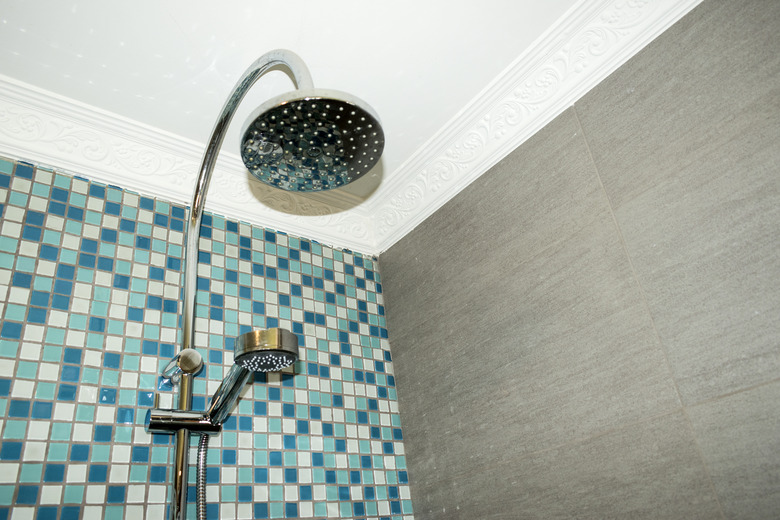How To Do A Mosaic Tile On An Inside Corner
Tile can brighten up a room and save you from doing expensive redecorations. In the kitchen, adding mosaic tile to your backsplash can give the room a whole new look without spending a lot of money. Adding mosaic tiles to your wall is pretty easy, especially with mosaic tile sheets, but getting the inside corners just right can be a bit tricky. Mosaic tile is available in tiny square tiles made of ceramic, glass or other material, or broken pottery combined with glass or other hard materials to make an attractive pattern.
Starting the Process
Starting the Process
Mosaic tile usually comes in 12-inch square sheets with mesh backing, although strips of 4-inch by 12-inch sheets are also available. Measure the space to see how many sheets are needed. You'll need to rent either a tile cutter or a wet saw to cut the tiles, and you'll also need a spirit level, tile adhesive, grout and caulk. Consider the type of tile you're using. Slate tiles can crumble when being cut. Ceramic and glass tiles are easier to cut. Make sure the wall is clean, level and ready for ceramic tiles. If the tile sheets are going to be placed onto drywall, make sure the drywall joints are sealed properly. If the wall has grease on it, clean the surface well because tile and tile sheets won't stick to grease. Dawn dish soap works well for this. If you can't get all the grease off, wipe on a paint deglosser. If you're installing mosaic tile sheets near a shower or kitchen or bathroom sink, consider using backer boards in these areas that are exposed to water.
Don't start your tiling job with the corner line. If you're using mosaic tile sheets with mesh backing, place the tile sheets on the wall using adhesive to make the tile stick. You should work from the center of the wall outward. Allow the adhesive to dry after you set the tiles. Fill any gaps between tiles with grout.
Cutting the Tiles
Cutting the Tiles
For tiling inside corners, measure your area and decide where cuts will need to be made. Use tile spacers between the tiles and along the corner line to allow for humidity and temperature changes in bathrooms and kitchens. This is the most important part of tiling an inside corner. Measure the distance from the last tile in the row to the corner, subtracting one-eighth of an inch for the expansion gap and also the thickness of the tile spacer. Slice the mesh backing to the nearest full row of tile. Then, use a wet saw or tile cutter to cut each tile to the correct size.
Tiling Inside Corners
Tiling Inside Corners
For full sheets of mosaic tiles along the inside corners, spread tile adhesive directly onto the wall using a notched 3/16-inch trowel. Spread a thin layer of adhesive, just thick enough to see the trowel lines. If you've cut the mosaic tile sheets to fit, spread a thin layer of adhesive to the back of the tile sheet and install each sheet with the cut edge pointing towards the inside corner. Also do this if you decide to go with individual tiles along the inside corners. You'll need to check the wall with a spirit level to make sure it's plumb and square. Make sure you keep your trowel clean and dry after each application and wipe off the adhesive that sticks to it with a wet sponge.
After you've installed the tiles, let the adhesive dry for 30 minutes. If you're using natural stone, slate or unglazed quarry tile, apply a grout sealer, which keeps the grout from sticking to the tile. You won't need to do this if you're using ceramic or other nonporous tiles. Then, remove the spacers.
Wipe grout over the corner lines just like you would with the rest of the tiles. Premium grout is recommended in kitchens where the backsplash tile may become stained and splattered from cooking. The premium grout will make the tile easier to clean. Mix the grout with water until it has the consistency of mashed potatoes, then apply it to the walls with a grout float held at a 45-degree angle to the tile. Scrape off excess grout and wait for the grout to harden. Wipe the surface after 10 minutes, rinsing the tiles until they're clean. Then, wipe the tiles with a microfiber cloth.
Wait two hours and then fill the corner lines with latex caulk using a color that matches the color of the grout. Use a water-resistant caulk, wiping off the excess with a damp sponge. A week later, sponge on a grout sealer to protect the grout against stains. Then, enjoy your newly tiled wall!
